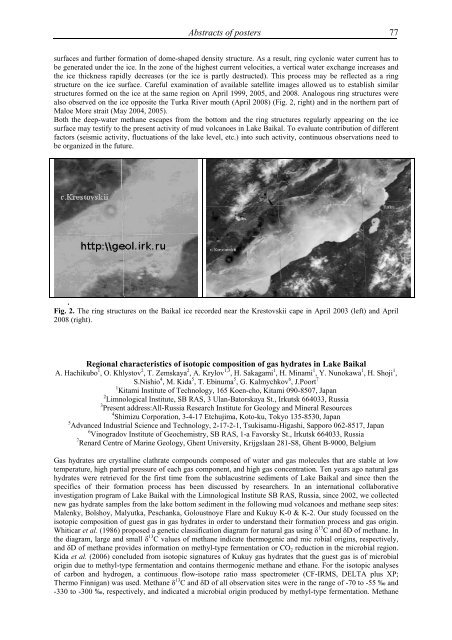Ninth international conference on - Marum
Ninth international conference on - Marum
Ninth international conference on - Marum
You also want an ePaper? Increase the reach of your titles
YUMPU automatically turns print PDFs into web optimized ePapers that Google loves.
Abstracts of posters 77<br />
surfaces and further formati<strong>on</strong> of dome-shaped density structure. As a result, ring cycl<strong>on</strong>ic water current has to<br />
be generated under the ice. In the z<strong>on</strong>e of the highest current velocities, a vertical water exchange increases and<br />
the ice thickness rapidly decreases (or the ice is partly destructed). This process may be reflected as a ring<br />
structure <strong>on</strong> the ice surface. Careful examinati<strong>on</strong> of available satellite images allowed us to establish similar<br />
structures formed <strong>on</strong> the ice at the same regi<strong>on</strong> <strong>on</strong> April 1999, 2005, and 2008. Analogous ring structures were<br />
also observed <strong>on</strong> the ice opposite the Turka River mouth (April 2008) (Fig. 2, right) and in the northern part of<br />
Maloe More strait (May 2004, 2005).<br />
Both the deep-water methane escapes from the bottom and the ring structures regularly appearing <strong>on</strong> the ice<br />
surface may testify to the present activity of mud volcanoes in Lake Baikal. To evaluate c<strong>on</strong>tributi<strong>on</strong> of different<br />
factors (seismic activity, fluctuati<strong>on</strong>s of the lake level, etc.) into such activity, c<strong>on</strong>tinuous observati<strong>on</strong>s need to<br />
be organized in the future.<br />
.<br />
Fig. 2. The ring structures <strong>on</strong> the Baikal ice recorded near the Krestovskii cape in April 2003 (left) and April<br />
2008 (right).<br />
Regi<strong>on</strong>al characteristics of isotopic compositi<strong>on</strong> of gas hydrates in Lake Baikal<br />
A. Hachikubo 1 , O. Khlystov 2 , T. Zemskaya 2 , A. Krylov 1,3 , H. Sakagami 1 , H. Minami 1 , Y. Nunokawa 1 , H. Shoji 1 ,<br />
S.Nishio 4 , M. Kida 5 , T. Ebinuma 5 , G. Kalmychkov 6 , J.Poort 7<br />
1 Kitami Institute of Technology, 165 Koen-cho, Kitami 090-8507, Japan<br />
2 Limnological Institute, SB RAS, 3 Ulan-Batorskaya St., Irkutsk 664033, Russia<br />
3 Present address:All-Russia Research Institute for Geology and Mineral Resources<br />
4 Shimizu Corporati<strong>on</strong>, 3-4-17 Etchujima, Koto-ku, Tokyo 135-8530, Japan<br />
5 Advanced Industrial Science and Technology, 2-17-2-1, Tsukisamu-Higashi, Sapporo 062-8517, Japan<br />
6 Vinogradov Institute of Geochemistry, SB RAS, 1-a Favorsky St., Irkutsk 664033, Russia<br />
7 Renard Centre of Marine Geology, Ghent University, Krijgslaan 281-S8, Ghent B-9000, Belgium<br />
Gas hydrates are crystalline clathrate compounds composed of water and gas molecules that are stable at low<br />
temperature, high partial pressure of each gas comp<strong>on</strong>ent, and high gas c<strong>on</strong>centrati<strong>on</strong>. Ten years ago natural gas<br />
hydrates were retrieved for the first time from the sublacustrine sediments of Lake Baikal and since then the<br />
specifics of their formati<strong>on</strong> process has been discussed by researchers. In an <str<strong>on</strong>g>internati<strong>on</strong>al</str<strong>on</strong>g> collaborative<br />
investigati<strong>on</strong> program of Lake Baikal with the Limnological Institute SB RAS, Russia, since 2002, we collected<br />
new gas hydrate samples from the lake bottom sediment in the following mud volcanoes and methane seep sites:<br />
Malenky, Bolshoy, Malyutka, Peschanka, Goloustnoye Flare and Kukuy K-0 & K-2. Our study focussed <strong>on</strong> the<br />
isotopic compositi<strong>on</strong> of guest gas in gas hydrates in order to understand their formati<strong>on</strong> process and gas origin.<br />
Whiticar et al. (1986) proposed a genetic classificati<strong>on</strong> diagram for natural gas using δ 13 C and δD of methane. In<br />
the diagram, large and small δ 13 C values of methane indicate thermogenic and mic robial origins, respectively,<br />
and δD of methane provides informati<strong>on</strong> <strong>on</strong> methyl-type fermentati<strong>on</strong> or CO2 reducti<strong>on</strong> in the microbial regi<strong>on</strong>.<br />
Kida et al. (2006) c<strong>on</strong>cluded from isotopic signatures of Kukuy gas hydrates that the guest gas is of microbial<br />
origin due to methyl-type fermentati<strong>on</strong> and c<strong>on</strong>tains thermogenic methane and ethane. For the isotopic analyses<br />
of carb<strong>on</strong> and hydrogen, a c<strong>on</strong>tinuous flow-isotope ratio mass spectrometer (CF-IRMS, DELTA plus XP;<br />
Thermo Finnigan) was used. Methane δ 13 C and δD of all observati<strong>on</strong> sites were in the range of -70 to -55 ‰ and<br />
-330 to -300 ‰, respectively, and indicated a microbial origin produced by methyl-type fermentati<strong>on</strong>. Methane














